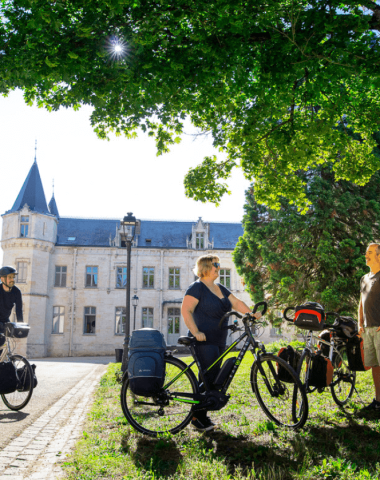To the north of Châteauroux, at Deols, rises a bell tower as the only vestige of ancient times. Its foundation dates back to 917. A man of the entourage of the Duke of Aquitaine, Ebbes of Bourges, said the Noble, Grand du Berry and Prince of Déols, founded a feudal house and, on the same model as that of Cluny, an abbey: Our Lady of Deols (or Bourg-Dieu). Its first abbots were the same abbots of Cluny. But from the Xe century, relations with the Cluniacs disappeared.


His history
The construction of the abbey is done in several stages until the XIVe century. It is thus a privileged witness to the emergence of Gothic sculpture in the XNUMXthe century. The abbey is one of the most important of its time both in terms of its architecture and its influence. It is thus probably one of the most flourishing religious establishments of the Middle Ages. Located on the pilgrimage route of Santiago de Compostela, the abbey has an extraordinary abbey church. Its seven bell towers and its remarkable dimensions (113 meters long for the abbey church) attract the vocations of nearly two hundred monks! One hundred and fifty churches and priories are also attached to it.
Despite the power of the abbey, a succession of terrible events such as the war of Hundred years or the wars of Religion lead it to its ruin. Partly destroyed in the XNUMXthe century by Protestant bands it was secularized for the benefit of the Prince of Conde in 1628 who then transformed it into a stone quarry. It remains so until the XNUMXth century.e century.
From Earth to Heaven with the medieval garden

Inspired by medieval horticultural treatises, the medieval garden of the abbey is made up of twelve squares, planted and surrounded by plessis. They thus symbolize the twelve Apostles of the Christian religion. The proposed route, from rue de l'Abbaye to the cloister of the old abbey, is borrowed from the medieval imagination and offers a metaphorical representation passing from Earth to Heaven through Love.
The visitor will thus be able to admire three distinct parts: the herb garden composed of plants used in the medieval pharmacopoeia, the love garden inspired by medieval poetry and courtly love and celestial garden dedicated to the Virgin Mary, symbol of the abbey.
The lapidary museum
Located on the site of the former refectory of the monks, the lapidary museum brings together the capitals of the abbey decorated with animals, monsters, with laminated or even historiated decoration. They highlight and breathe new life into a site rich in 1 years of history. A virtual tour will also show you the interior of the abbey as it was in its heyday.


Opening time
Notre-Dame de Déols abbey and its lapidary museum can be visited free of charge all year round.
| from 02 / 11 to 31 / 03 | from 01 / 04 to 20 / 06 and from 22/09 to 30/10 | from 21 / 06 to 21 / 09 |
|---|---|---|
| Tuesday to Saturday from 10 p.m. to 12 p.m. and from 14 p.m. to 17 p.m. | Tuesday to Saturday from 10 a.m. to 12:30 p.m. and from 13:30 p.m. to 18 p.m. | From Monday to Saturday from 9h30 to 12h30 and from 13 p.m. to 30 p.m. |
| Closed on sunday and monday | Closed on sunday and monday | Sundays and public holidays from 10 a.m. to 12 p.m. and from 30 p.m. to 15 p.m. |
Is it possible to climb to the top of the bell tower?
Climbs to the bell tower are organized on request.
- Information on 02 54 07 58 87.
- Price: €2 per person
Is the medieval garden permanently accessible?
Part of the medieval garden is accessible all year round, day and night.
Can I organize a school trip with my students to Notre-Dame Abbey?
Many educational activities can be offered to children to discover the abbey in a fun way: game-investigation, workshop, etc.
- Information on 02 54 07 58 87.











